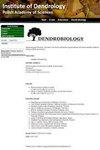在减雨试验中,云杉细根补偿了干旱胁迫
IF 1.8
4区 农林科学
Q2 FORESTRY
引用次数: 3
摘要
本研究评估了重复人工干旱胁迫对挪威云杉(Picea abies (L.))细根特征(包括外生菌根)的影响。岩溶]。试验场地由一个成熟的云杉单一林分的两个地块组成。自2010年以来,在植被季节(春季至秋季),两个地块的部分地区的水状况由庇护所和隔离沟调节。2010年、2012年和2013年秋季采集根样。根系分析显示,干旱胁迫对菌根根尖的影响随时间而变化。2010年,干旱胁迫地区的活性菌根密度比非干旱(对照)地区低34%左右,但2012年和2013年两样地的活性菌根密度分别增加了15%和22%。我们观察到干旱对活性菌根比例的影响不太明显,但它通常遵循活性菌根密度的模式。非活性菌根的密度不受干旱的影响,但在试验过程中有显著的波动。其他根系特征,如细根干质量(< 1 mm)、细根比长(< 1 mm)和外生菌根群落组成(主要以Amphinema byssoides、Tylospora fibrillosa、Tylopilus felleus和cenococum geophilum为主)也不受干旱的显著影响。我们的结果表明挪威云杉细根补偿中等强度的反复干旱胁迫的能力。本文章由计算机程序翻译,如有差异,请以英文原文为准。
Fine roots of Picea abies compensate for drought stress in the rainfall reduction experiment
This study evaluates the influence of repeated artificial drought stress on the fine root characteristics – including ectomycorrhizae – of Norway spruce [Picea abies (L.) Karst]. The experimental site consisted of two plots in a mature spruce monoculture stand. The water regime at parts of both plots was regulated by shelters and an isolation trench during vegetation season (spring to autumn) since 2010. Root samples were collected during autumn in 2010, 2012, and 2013. Root analyses revealed the effect of drought stress on mycorrhizal root tips changed over time. While a density of active mycorrhizae was about 34% lower in drought-stressed areas compared to nonstressed (control) areas in 2010, it increased by 15% in 2012 and by 22% in 2013 over both plots. We observed the less pronounced effect of drought on a proportion of active mycorrhizae, but it generally followed the pattern of active mycorrhizae density. The density of nonactive mycorrhizae was not influenced by drought but significantly fluctuated during the course of the experiment. Other root characteristics such as the dry mass of fine roots (< 1 mm), the specific length of fine roots (< 1 mm) and the composition of the ectomycorrhizal community (primarily dominated by Amphinema byssoides, Tylospora fibrillosa, Tylopilus felleus, and Cenococcum geophilum) were also not significantly influenced by drought. Our results indicate the ability of Norway spruce fine roots to compensate for repeated drought stress of the intermediate intensity.
求助全文
通过发布文献求助,成功后即可免费获取论文全文。
去求助
来源期刊

Dendrobiology
农林科学-林学
CiteScore
2.20
自引率
11.10%
发文量
17
审稿时长
>12 weeks
期刊介绍:
Dendrobiology publishes original research articles and review articles related to the biology of trees and shrubs.
 求助内容:
求助内容: 应助结果提醒方式:
应助结果提醒方式:


